Using dynamic art, energy dashboards and building information systems to inspire energy savings from occupants and owners.

By Amanda Ross, Architect
Since the first versions of LEED, architects have been using signage and displays to educate and inspire building occupants to save energy and water. It was based on a simple idea: educate people on ways to reduce energy and water use, and they will be more likely to do so. While this is true, and most of the first installations were very educational, the design of many of these displays tended to be technical, wordy and easy to ignore.
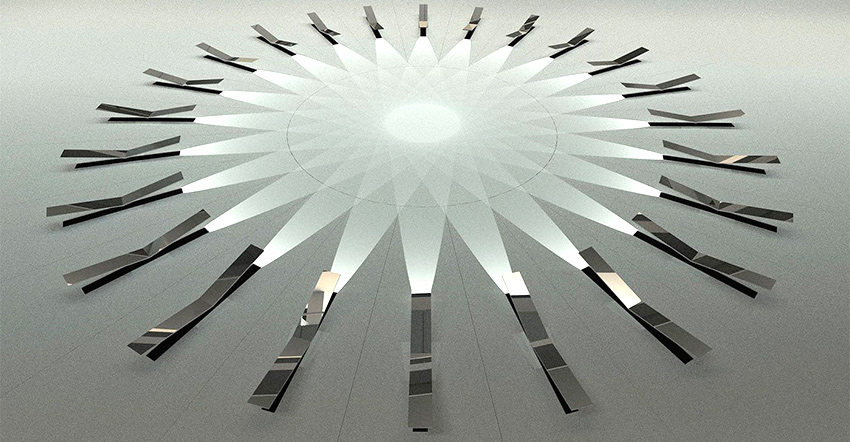 Image: United Therapeutics / Hush Studios
Image: United Therapeutics / Hush Studios
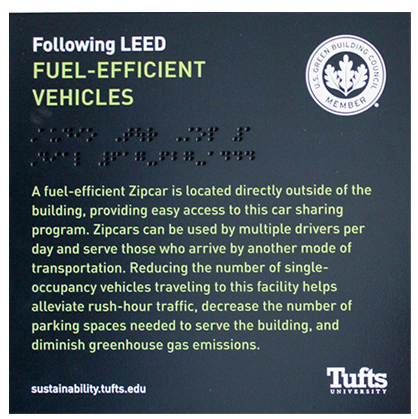 Fortunately, today’s designers have artists, makers and programmers, in addition to architects and engineers, and together with the latest technology, they can create stunning, inspiring, building integrated art, which changes to reflect and influence the real-time performance of the building and its occupants.
Fortunately, today’s designers have artists, makers and programmers, in addition to architects and engineers, and together with the latest technology, they can create stunning, inspiring, building integrated art, which changes to reflect and influence the real-time performance of the building and its occupants.
Image: Easy to ignore - technical, wordy and static displays were typical of the first sustainability signage installations.
United Therapeutics "The Unisphere" from HUSH on Vimeo.
The Unisphere, a new, net-zero office building in Silver Spring, Maryland has a great example of an energy-art display that has all of these elements. The “Energy Wheel” is a full-storey high, sundial-like sculpture, which shows more dramatic and classy light displays and animations when the building is operating with an energy surplus (from solar panels), than when it is in an energy deficit. This encourages occupants to save energy in order to get the ‘reward’ of seeing the more dramatic light display. Even those occupants who are not inspired to take action, cannot help but be aware of the overall building performance (surplus or deficit) on a daily basis. For those occupants at Unisphere who wish to know more details about energy use & production, there is an electronic energy dashboard.
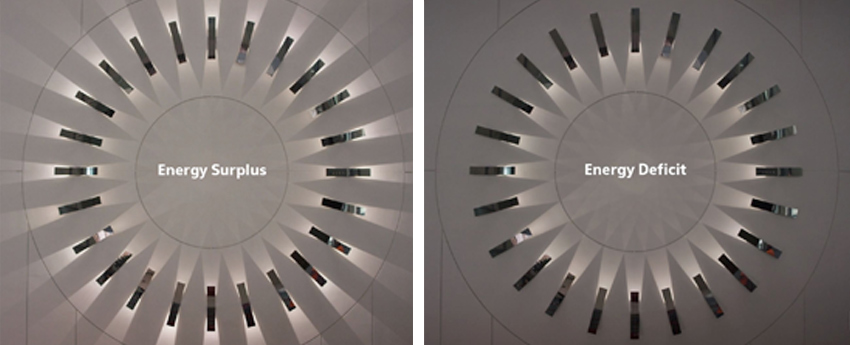 Hush Energy Wheel showing energy deficit & surplus.
Hush Energy Wheel showing energy deficit & surplus.
![]()
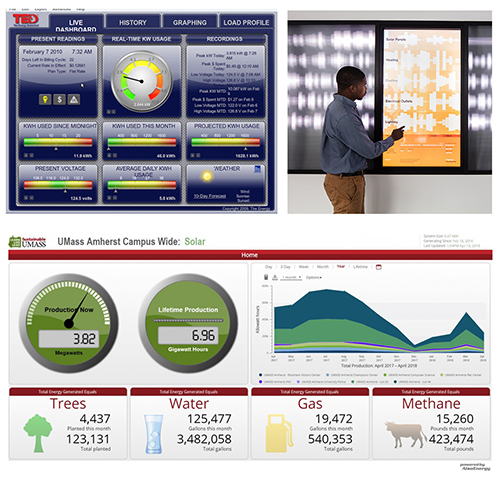 Energy dashboards have been around for a few years, and are like a Fitbit for a building. Instead of tracking biological data (steps, heartrate, activity level), dashboards track building data, including things like water use, energy use/production and sometimes waste generation. Like Fitbits, they do it in real time, and analyse and summarize that data for users, comparing it against historical data or averages. This allows people to see how their individual personal choices are affecting their health (for Fitbits) or their building performance (for energy dashboards), and make changes to improve their performance. Well-designed dashboards and building information management systems can be a very valuable tool for property managers or owners, and can be educational and informative for curious occupants, but like their historic signage precedents, they are still technical, relatively easy to ignore, and often not well integrated into the aesthetic design of the building.
Energy dashboards have been around for a few years, and are like a Fitbit for a building. Instead of tracking biological data (steps, heartrate, activity level), dashboards track building data, including things like water use, energy use/production and sometimes waste generation. Like Fitbits, they do it in real time, and analyse and summarize that data for users, comparing it against historical data or averages. This allows people to see how their individual personal choices are affecting their health (for Fitbits) or their building performance (for energy dashboards), and make changes to improve their performance. Well-designed dashboards and building information management systems can be a very valuable tool for property managers or owners, and can be educational and informative for curious occupants, but like their historic signage precedents, they are still technical, relatively easy to ignore, and often not well integrated into the aesthetic design of the building.
Art often evokes emotion and strong reactions, so it’s no surprise that energy-art displays are much more likely to capture and hold everyone’s attention. There are so many examples of responsive, programmable art in the world today, that it’s easy to imagine some of them customized to display building energy usage:
 Giant Dandilion lights at the Singapore iLight Festival could simply dim or turn blue when the building is performing more poorly. Image: ilightmarinabay.sg | Dune’ light bushes from the Singapore iLight Festival could be programmed to pulsate and create more intense patterns at higher energy savings. Image: Studio Roosegaarde / www.studioroosegaarde.net
Giant Dandilion lights at the Singapore iLight Festival could simply dim or turn blue when the building is performing more poorly. Image: ilightmarinabay.sg | Dune’ light bushes from the Singapore iLight Festival could be programmed to pulsate and create more intense patterns at higher energy savings. Image: Studio Roosegaarde / www.studioroosegaarde.net
 Puzzlebox Bloom lights (https://youtu.be/KhwO3Cl5jvA) | image: https://puzzlebox.io/bloom/) and the Adaptive Bloom installation (https://youtu.be/ceRKKH29YGM) are designed to have the robotic flowers open in response to various inputs. They could be installed in a building and programmed to open and create beautiful blooming movement patterns in response to greater energy savings.
Puzzlebox Bloom lights (https://youtu.be/KhwO3Cl5jvA) | image: https://puzzlebox.io/bloom/) and the Adaptive Bloom installation (https://youtu.be/ceRKKH29YGM) are designed to have the robotic flowers open in response to various inputs. They could be installed in a building and programmed to open and create beautiful blooming movement patterns in response to greater energy savings.
 "Skies painted with unnumbered sparks" installation has users interact through their phones to modify the colour and design of the images projected on the light, suspended net. A similar idea could be used to project energy savings in an abstract, artistic way, on fabric art, or even on a building facade. (image: Ema Peter)
"Skies painted with unnumbered sparks" installation has users interact through their phones to modify the colour and design of the images projected on the light, suspended net. A similar idea could be used to project energy savings in an abstract, artistic way, on fabric art, or even on a building facade. (image: Ema Peter)
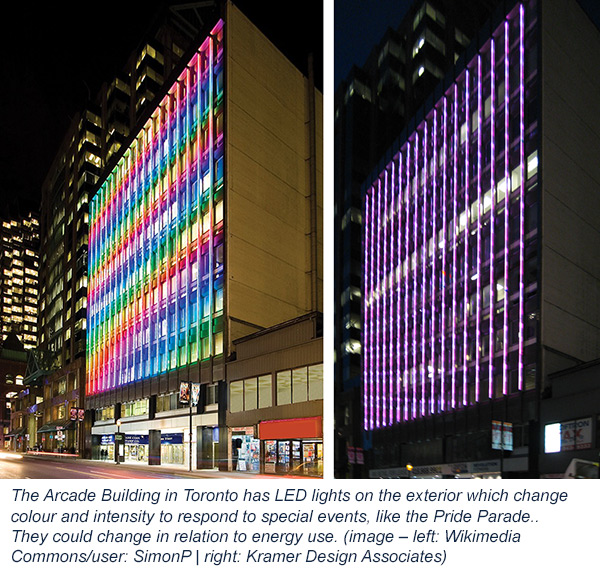 The downside is that, due to their abstract and emotional nature, energy-art displays are limited to much simpler messages than dashboards: for example, is the building performing better or worse than average. However, when used in conjunction with an energy dashboard, the best scenario is achieved: more occupants are aware and interested in the building performance through the energy-art, and therefore many more are likely to seek out and investigate the data within the dashboard. Also, because the energy-art is there to capture attention, the dashboard can be an online tool which people can access from their phones, instead of through a fixed display monitor.
The downside is that, due to their abstract and emotional nature, energy-art displays are limited to much simpler messages than dashboards: for example, is the building performing better or worse than average. However, when used in conjunction with an energy dashboard, the best scenario is achieved: more occupants are aware and interested in the building performance through the energy-art, and therefore many more are likely to seek out and investigate the data within the dashboard. Also, because the energy-art is there to capture attention, the dashboard can be an online tool which people can access from their phones, instead of through a fixed display monitor.
 (images – left: https://www.continentaloffice.com | right: https://theinspirationgrid.com/)
(images – left: https://www.continentaloffice.com | right: https://theinspirationgrid.com/)
Some fixed signage is still important for describing the meaning of the energy-art display, and listing the website or location of the energy dashboard, but it can also be creative. Blending interior design, wall art and signage can enliven the interior and make the building’s sustainable attributes and displays an integral part of the aesthetic.
Together, energy-art displays, dashboards and integrated signage can have a significant effect of the long-term sustainability and energy use of the building. It can inspire everything from simple, occupant changes (powersaver modes, turning off devices and lights), to building systems management changes (optimizing mechanical setpoints to reflect changing occupant needs, keeping equipment well maintained and efficient), to organizational culture shifts (updating purchasing policies to prioritize energy efficient equipment, and funding energy efficiency upgrades and building retrofits). This is because art is a natural vehicle for transformational change. It is designed to evoke a response or an emotion. By harnessing the emotional power of art, we can inspire more people to save energy. By using the metrics and data analysed by dashboards, we can give them the information on how to save energy. By incorporating it into the aesthetic and architecture of the building, we make energy saving and integrated part of everyday life.
Amanda Ross is an architect at Number TEN Architectural Group